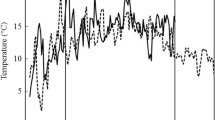Summary
Studies were made of days to ear emergence under the constant temperatures of 9, 14, 19 and 25°C and 16 h photoperiod in three sets of wheat lines each possessing genotypes differing for developmental responses.
Days to ear emergence in three near-isogenic lines of the wheat cultivar Triple Dirk, which differed for vernalization response, increased as the strength of the response increased. At the four temperatures Triple Dirk D (Vrn 1 vrn 2) was not significantly different from normal Triple Dirk (Vrn 1 Vrn 2) but Triple Dirk B (vrn 1 Vrn 2) was significantly (P=0.01) later than normal Triple Dirk at each temperature. This indicates that the vrn 1 allele confers stronger vernalization response than vrn 2 over the range of temperatures (9–24°C). However, Triple Dirk C (vrn 1 vrn 2) failed to head after 120 days at each temperature indicating strong interaction between vrn 1 and vrn 2 with each other (and possibly the Triple Dirk back-ground) to give a much stronger vernalization response than predictions from additivity of their individual effects.
The second set comprised the four Chinese Spring/Thatcher chromosome substitution lines CS/T 3B, 6B, 7B and 5D, plus Chinese Spring and Thatcher, and were grown in the unvernalized condition. CS/T 5D was similar in days to ear emergence as Chinese Spring at all four temperatures but the other three lines were earlier to ear emergence, particularly as the temperature increased. Days to ear emergence was fastest at 14°C in all lines, except CS/T 3B, in which it decreased progressively from 9 to 24°C.
The third set of Chinese Spring and Thatcher and the homoeologous group 2 chromosomes of Thatcher substituted in Chinese Spring, the group which is considered to be involved in the control of photoperiod sensitivity. The three substitution lines responded differently to temperature compared with Chinese Spring and with each other, with chromosome 2D being the least, and chromosome 2B the most, responsive to temperature.
Similar content being viewed by others
References
Berry, G. J., P. A.Salisbury & G. M.Halloran, 1980. Expression of vernalization genes in near-isogenic lines: duration of vernalization period. Ann. Bot. 46: 235–240.
Flood, R. G. & G. M.Halloran, 1983. The influence of certain chromosomes of the hexaploid wheat cultivar Thatcher on time to ear emergence in Chinese Spring. Euphytica 32: 121–124.
Ford, M. A., R. B.Austin, W. J.Angus & G. C. M.Sage, 1981. Relationships between the responses of spring wheat genotypes to temperature and photoperiodic treatments and their performance in the field. J. Agric. Sci., Cam. 96: 623–634.
Halloran, G. M., 1975. Genetic analysis of time to ear emergence in hexaploid wheat, Triticum aestivum, using intervarietal substitution lines. Can. J. Genet. Cytol. 17: 365–634.
Halloran, G. M., 1977. Developmental basis of maturity differences in spring wheat. Agron. J. 69: 899–902.
Halloran, G. M., 1983. Variability of natural populations of Triticum monococcum. Euphytica (In press).
Halloran, G. M. & C. W.Boydell, 1967. Wheat chromosomes with genes for vernalization response. Can. J. Genet. Cytol. 9: 632–639.
Halloran, G. M. & A. L.Pennell, 1982. Duration and rate of development phases in wheat in two environments. Ann. Bot. 49: 115–121.
Halse, N. H. & R. N.Weir, 1970. Effects of vernalization, photoperiod and temperature on phenological development and spikelet number of Australian wheats. Aust. J. Agric. Res. 21: 383–393.
Kushnir, U. & G. M.Halloran, 1982. Quantitative studies of the amphidiploid (Aegilops sharonensis x Triticum monococcum) and the origin of the B genome in wheat. Wheat Information Service 54: 12–16.
Law, C. N., J.Sutka & A. J.Worland, 1978. A genetic study of daylength response in wheat. Heredity 41: 185–191.
Marcellos, H. & W. V.Single, 1971. Quantitative responses of wheat to photoperiod and temperature in the field. Aust. J. Agric. Res. 22: 343–357.
Morse, R. N. & L. T.Evans, 1962. Design and development of CERES—an Australian phytotron. J. Agric. Engng. Res. 7: 128–140.
McIntosh, R. A., 1973. A catalogue of gene symbols for wheat. Proc. 4th Int. Wheat Genet. Symp., pp. 893–937. University of Missouri, Columbia.
Pugsley, A. T., 1968. Genetic studies of phasic development and their application to wheat breeding. Proc. 3rd Int. Wheat Genet. Symp. pp. 288–293. Aust. Acad. Sci., Canberra.
Pugsley, A. T., 1970. Thirty years' improvement of Dirk wheat. Annual Wheat Newsletter 17: 21. National Wheat Improvement Committee, U.S.A.
Pugsley, A. T., 1971. A genetic analysis of the springwinter habit of growth in wheat. Aust. J. Agric. Res. 22: 21–31.
Pugsley, A. T., 1972. Additional genes inhibiting winter habit in wheat. Euphytica 21: 547–552.
Quinby, J. R., 1967. The maturity genes of sorghum. Adv. Agron. 19: 267–304.
Rahman, M. S., G. M.Halloran & J. H.Wilson, 1978. Genetic control of spikelet number per ear with particular reference to rate of spikelet initiation in hexaploid wheat, Triticum aestivum L. em. Thell. Euphytica 27: 69–74.
Wall, P. C. & P. M.Cartwright, 1974. Effects of photoperiod, temperature and vernalization on the phenology and spikelet numbers of spring wheats. Ann. App. Bio. 76: 299–309.
Zohary, D., J. R.Harlan & A.Vardi, 1969. The wild diploid progenitors of wheat and their breeding value. Euphytica 18: 58–65.
Author information
Authors and Affiliations
Rights and permissions
About this article
Cite this article
Flood, R.G., Halloran, G.M. Temperature as a component of the expression of developmental responses in wheat. Euphytica 33, 91–98 (1984). https://doi.org/10.1007/BF00022754
Received:
Issue Date:
DOI: https://doi.org/10.1007/BF00022754




